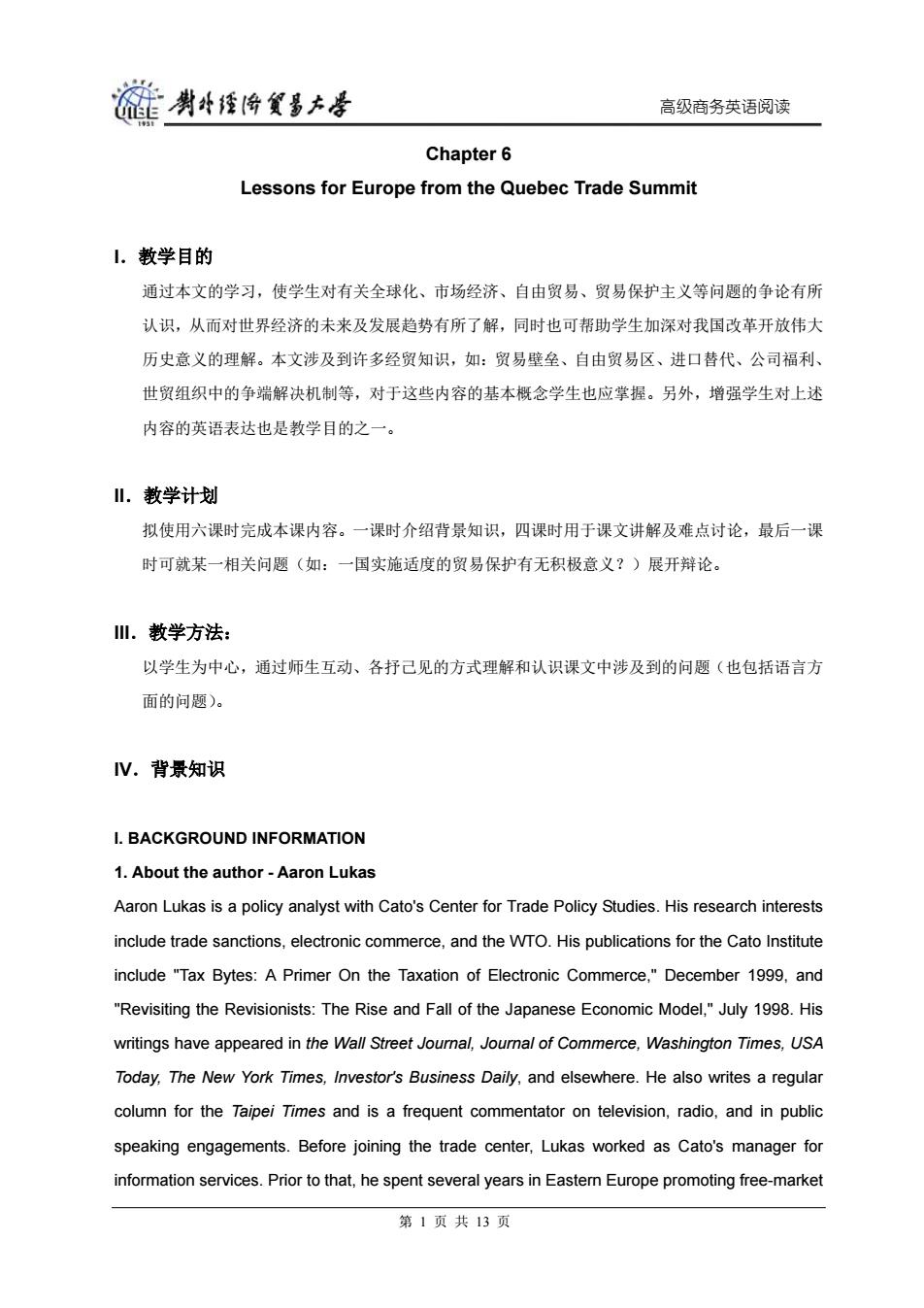
莲喇母矮将贸多大学 高级商务英语阅读 Chapter 6 Lessons for Europe from the Quebec Trade Summit 1.教学目的 通过本文的学习,使学生对有关全球化、市场经济、自由贸易、贸易保护主义等问题的争论有所 认识,从而对世界经济的未来及发展趋势有所了解,同时也可帮助学生加深对我国改革开放伟大 历史意义的理解。本文涉及到许多经贸知识,如:贸易壁垒、自由贸易区、进口替代、公司福利、 世贸组织中的争端解决机制等,对于这些内容的基本概念学生也应掌握。另外,增强学生对上述 内容的英语表达也是教学目的之一。 Ⅱ.教学计划 拟使用六课时完成本课内容。一课时介绍背景知识,四课时用于课文讲解及难点讨论,最后一课 时可就某一相关问题(如:一国实施适度的贸易保护有无积极意义?)展开辩论。 川.教学方法: 以学生为中心,通过师生互动、各抒己见的方式理解和认识课文中涉及到的问题(也包括语言方 面的问题)。 IV.背景知识 I.BACKGROUND INFORMATION 1.About the author-Aaron Lukas Aaron Lukas is a policy analyst with Cato's Center for Trade Policy Studies.His research interests include trade sanctions,electronic commerce,and the WTO.His publications for the Cato Institute include "Tax Bytes:A Primer On the Taxation of Electronic Commerce,"December 1999,and "Revisiting the Revisionists:The Rise and Fall of the Japanese Economic Model,"July 1998.His writings have appeared in the Wall Street Journal,Journal of Commerce,Washington Times,USA Today,The New York Times,Investor's Business Daily,and elsewhere.He also writes a regular column for the Taipei Times and is a frequent commentator on television,radio,and in public speaking engagements.Before joining the trade center,Lukas worked as Cato's manager for information services.Prior to that,he spent several years in Eastern Europe promoting free-market 第1页共13页
高级商务英语阅读 Chapter 6 Lessons for Europe from the Quebec Trade Summit I.教学目的 通过本文的学习,使学生对有关全球化、市场经济、自由贸易、贸易保护主义等问题的争论有所 认识,从而对世界经济的未来及发展趋势有所了解,同时也可帮助学生加深对我国改革开放伟大 历史意义的理解。本文涉及到许多经贸知识,如:贸易壁垒、自由贸易区、进口替代、公司福利、 世贸组织中的争端解决机制等,对于这些内容的基本概念学生也应掌握。另外,增强学生对上述 内容的英语表达也是教学目的之一。 II.教学计划 拟使用六课时完成本课内容。一课时介绍背景知识,四课时用于课文讲解及难点讨论,最后一课 时可就某一相关问题(如:一国实施适度的贸易保护有无积极意义?)展开辩论。 III.教学方法: 以学生为中心,通过师生互动、各抒己见的方式理解和认识课文中涉及到的问题(也包括语言方 面的问题)。 IV.背景知识 I. BACKGROUND INFORMATION 1. About the author - Aaron Lukas Aaron Lukas is a policy analyst with Cato's Center for Trade Policy Studies. His research interests include trade sanctions, electronic commerce, and the WTO. His publications for the Cato Institute include "Tax Bytes: A Primer On the Taxation of Electronic Commerce," December 1999, and "Revisiting the Revisionists: The Rise and Fall of the Japanese Economic Model," July 1998. His writings have appeared in the Wall Street Journal, Journal of Commerce, Washington Times, USA Today, The New York Times, Investor's Business Daily, and elsewhere. He also writes a regular column for the Taipei Times and is a frequent commentator on television, radio, and in public speaking engagements. Before joining the trade center, Lukas worked as Cato's manager for information services. Prior to that, he spent several years in Eastern Europe promoting free-market 第 1 页 共 13 页
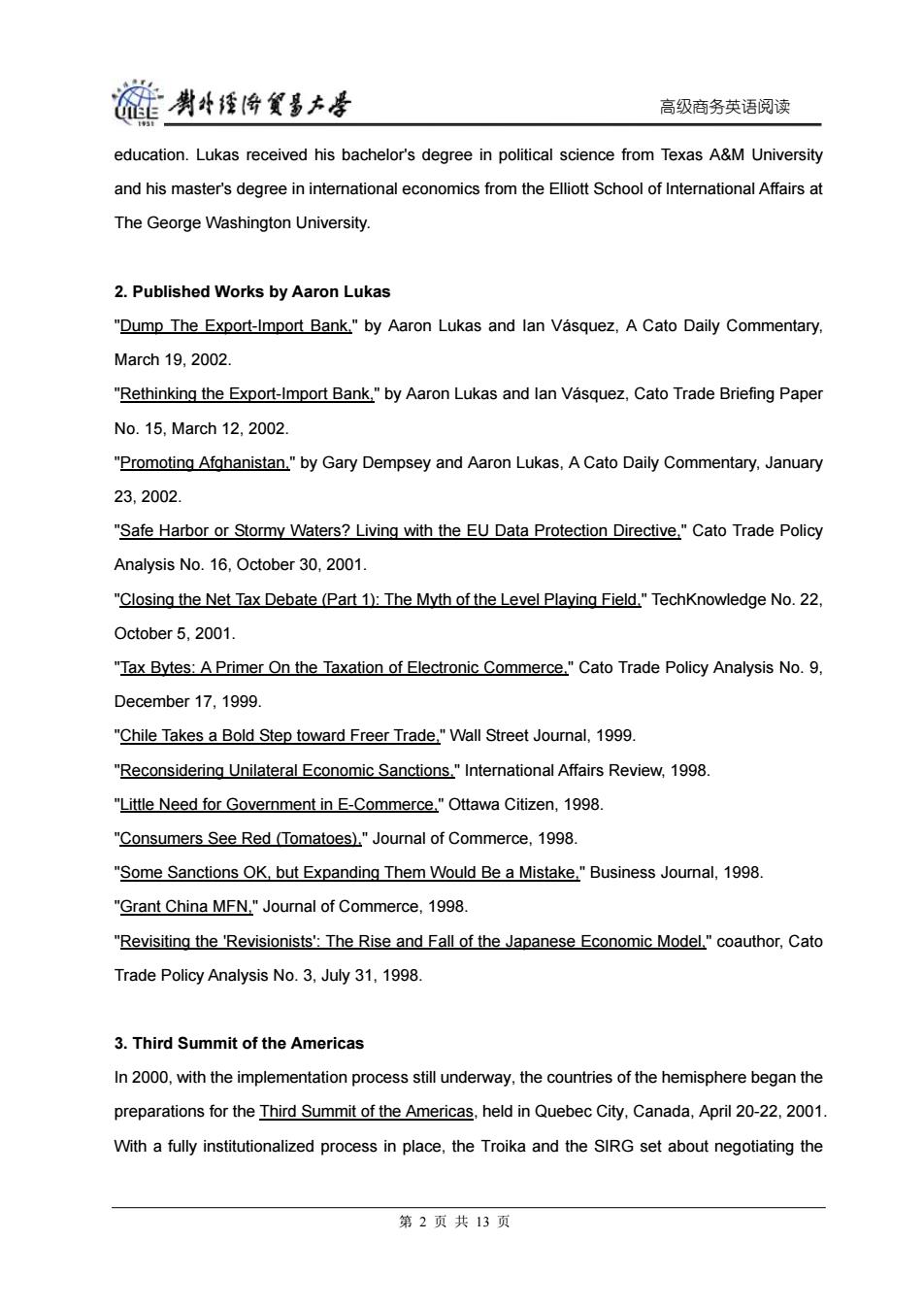
雒剥经降置昌大号 高级商务英语阅读 education.Lukas received his bachelor's degree in political science from Texas A&M University and his master's degree in international economics from the Elliott School of International Affairs at The George Washington University. 2.Published Works by Aaron Lukas "Dump The Export-Import Bank,"by Aaron Lukas and lan Vasquez,A Cato Daily Commentary, March 19.2002 "Rethinking the Export-Import Bank,"by Aaron Lukas and lan Vasquez,Cato Trade Briefing Paper No.15,March12,2002. "Promoting Afghanistan."by Gary Dempsey and Aaron Lukas,A Cato Daily Commentary,January 23,2002. "Safe Harbor or Stormy Waters?Living with the EU Data Protection Directive,"Cato Trade Policy Analysis No.16,October 30,2001. "Closing the Net Tax Debate (Part 1):The Myth of the Level Playing Field,"TechKnowledge No.22, October 5,2001. "Tax Bytes:A Primer On the Taxation of Electronic Commerce,"Cato Trade Policy Analysis No.9, December 17,1999 "Chile Takes a Bold Step toward Freer Trade,"Wall Street Journal,1999. "Reconsidering Unilateral Economic Sanctions."International Affairs Review,1998. "Little Need for Government in E-Commerce,"Ottawa Citizen,1998. "Consumers See Red (Tomatoes)."Journal of Commerce,1998. "Some Sanctions OK,but Expanding Them Would Be a Mistake,Business Journal,1998. "Grant China MFN,"Journal of Commerce,1998. "Revisiting the 'Revisionists':The Rise and Fall of the Japanese Economic Model,"coauthor,Cato Trade Policy Analysis No.3,July 31,1998. 3.Third Summit of the Americas In 2000,with the implementation process still underway,the countries of the hemisphere began the preparations for the Third Summit of the Americas,held in Quebec City,Canada,April 20-22,2001. With a fully institutionalized process in place,the Troika and the SIRG set about negotiating the 第2页共13页
高级商务英语阅读 education. Lukas received his bachelor's degree in political science from Texas A&M University and his master's degree in international economics from the Elliott School of International Affairs at The George Washington University. 2. Published Works by Aaron Lukas "Dump The Export-Import Bank," by Aaron Lukas and Ian Vásquez, A Cato Daily Commentary, March 19, 2002. "Rethinking the Export-Import Bank," by Aaron Lukas and Ian Vásquez, Cato Trade Briefing Paper No. 15, March 12, 2002. "Promoting Afghanistan," by Gary Dempsey and Aaron Lukas, A Cato Daily Commentary, January 23, 2002. "Safe Harbor or Stormy Waters? Living with the EU Data Protection Directive," Cato Trade Policy Analysis No. 16, October 30, 2001. "Closing the Net Tax Debate (Part 1): The Myth of the Level Playing Field," TechKnowledge No. 22, October 5, 2001. "Tax Bytes: A Primer On the Taxation of Electronic Commerce," Cato Trade Policy Analysis No. 9, December 17, 1999. "Chile Takes a Bold Step toward Freer Trade," Wall Street Journal, 1999. "Reconsidering Unilateral Economic Sanctions," International Affairs Review, 1998. "Little Need for Government in E-Commerce," Ottawa Citizen, 1998. "Consumers See Red (Tomatoes)," Journal of Commerce, 1998. "Some Sanctions OK, but Expanding Them Would Be a Mistake," Business Journal, 1998. "Grant China MFN," Journal of Commerce, 1998. "Revisiting the 'Revisionists': The Rise and Fall of the Japanese Economic Model," coauthor, Cato Trade Policy Analysis No. 3, July 31, 1998. 3. Third Summit of the Americas In 2000, with the implementation process still underway, the countries of the hemisphere began the preparations for the Third Summit of the Americas, held in Quebec City, Canada, April 20-22, 2001. With a fully institutionalized process in place, the Troika and the SIRG set about negotiating the 第 2 页 共 13 页
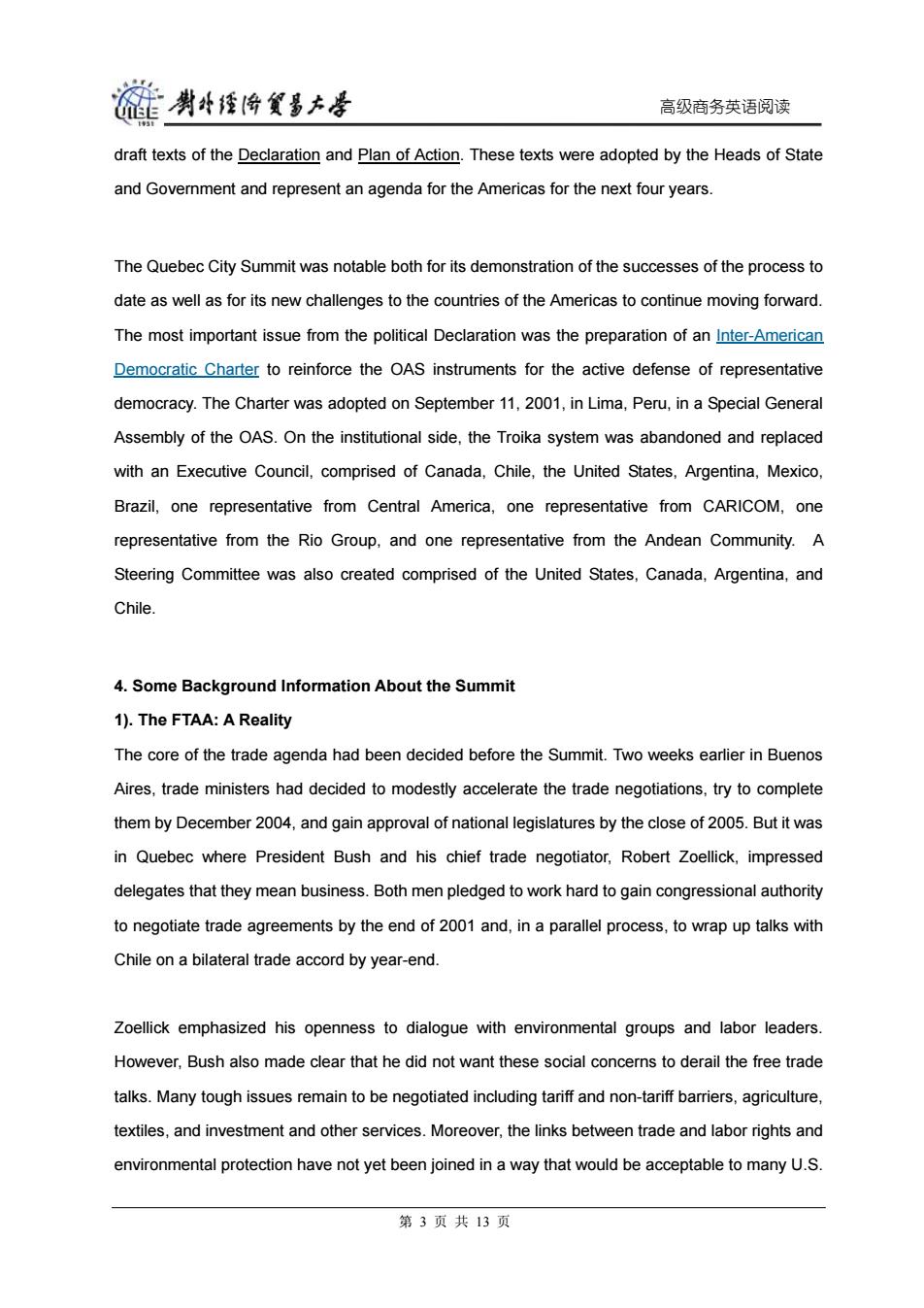
链剥头经将复多大是 高级商务英语阅读 draft texts of the Declaration and Plan of Action.These texts were adopted by the Heads of State and Government and represent an agenda for the Americas for the next four years. The Quebec City Summit was notable both for its demonstration of the successes of the process to date as well as for its new challenges to the countries of the Americas to continue moving forward. The most important issue from the political Declaration was the preparation of an Inter-American Democratic Charter to reinforce the OAS instruments for the active defense of representative democracy.The Charter was adopted on September 11,2001,in Lima,Peru,in a Special General Assembly of the OAS.On the institutional side,the Troika system was abandoned and replaced with an Executive Council,comprised of Canada,Chile,the United States,Argentina,Mexico, Brazil,one representative from Central America,one representative from CARICOM,one representative from the Rio Group,and one representative from the Andean Community.A Steering Committee was also created comprised of the United States,Canada,Argentina,and Chile. 4.Some Background Information About the Summit 1).The FTAA:A Reality The core of the trade agenda had been decided before the Summit.Two weeks earlier in Buenos Aires,trade ministers had decided to modestly accelerate the trade negotiations,try to complete them by December 2004,and gain approval of national legislatures by the close of 2005.But it was in Quebec where President Bush and his chief trade negotiator,Robert Zoellick,impressed delegates that they mean business.Both men pledged to work hard to gain congressional authority to negotiate trade agreements by the end of 2001 and,in a parallel process,to wrap up talks with Chile on a bilateral trade accord by year-end. Zoellick emphasized his openness to dialogue with environmental groups and labor leaders. However,Bush also made clear that he did not want these social concerns to derail the free trade talks.Many tough issues remain to be negotiated including tariff and non-tariff barriers,agriculture, textiles,and investment and other services.Moreover,the links between trade and labor rights and environmental protection have not yet been joined in a way that would be acceptable to many U.S. 第3页共13页
高级商务英语阅读 draft texts of the Declaration and Plan of Action. These texts were adopted by the Heads of State and Government and represent an agenda for the Americas for the next four years. The Quebec City Summit was notable both for its demonstration of the successes of the process to date as well as for its new challenges to the countries of the Americas to continue moving forward. The most important issue from the political Declaration was the preparation of an Inter-American Democratic Charter to reinforce the OAS instruments for the active defense of representative democracy. The Charter was adopted on September 11, 2001, in Lima, Peru, in a Special General Assembly of the OAS. On the institutional side, the Troika system was abandoned and replaced with an Executive Council, comprised of Canada, Chile, the United States, Argentina, Mexico, Brazil, one representative from Central America, one representative from CARICOM, one representative from the Rio Group, and one representative from the Andean Community. A Steering Committee was also created comprised of the United States, Canada, Argentina, and Chile. 4. Some Background Information About the Summit 1). The FTAA: A Reality The core of the trade agenda had been decided before the Summit. Two weeks earlier in Buenos Aires, trade ministers had decided to modestly accelerate the trade negotiations, try to complete them by December 2004, and gain approval of national legislatures by the close of 2005. But it was in Quebec where President Bush and his chief trade negotiator, Robert Zoellick, impressed delegates that they mean business. Both men pledged to work hard to gain congressional authority to negotiate trade agreements by the end of 2001 and, in a parallel process, to wrap up talks with Chile on a bilateral trade accord by year-end. Zoellick emphasized his openness to dialogue with environmental groups and labor leaders. However, Bush also made clear that he did not want these social concerns to derail the free trade talks. Many tough issues remain to be negotiated including tariff and non-tariff barriers, agriculture, textiles, and investment and other services. Moreover, the links between trade and labor rights and environmental protection have not yet been joined in a way that would be acceptable to many U.S. 第 3 页 共 13 页
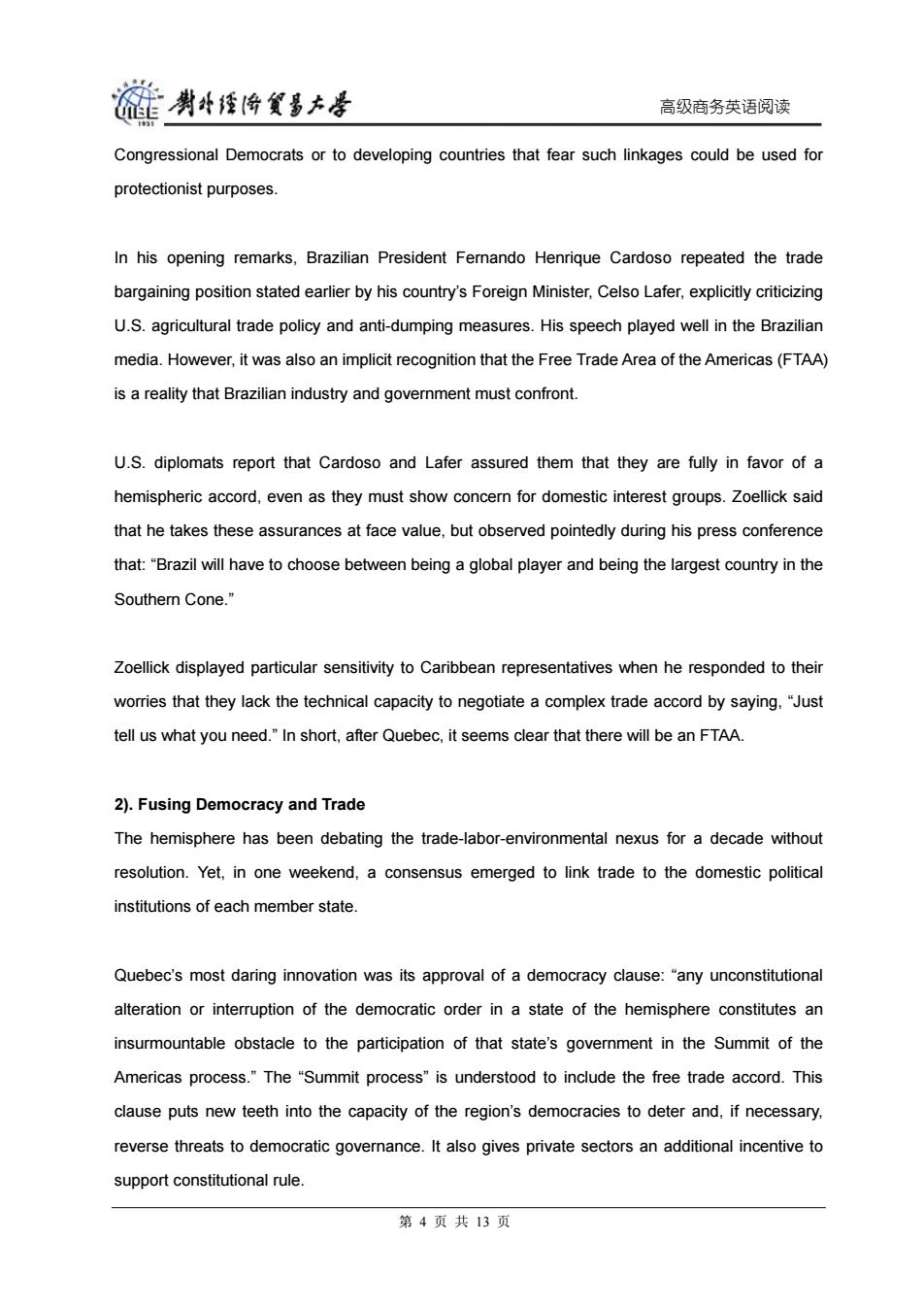
爸剥撞降餐多大学 高级商务英语阅读 Congressional Democrats or to developing countries that fear such linkages could be used for protectionist purposes. In his opening remarks,Brazilian President Fernando Henrique Cardoso repeated the trade bargaining position stated earlier by his country's Foreign Minister,Celso Lafer,explicitly criticizing U.S.agricultural trade policy and anti-dumping measures.His speech played well in the Brazilian media.However,it was also an implicit recognition that the Free Trade Area of the Americas(FTAA) is a reality that Brazilian industry and government must confront. U.S.diplomats report that Cardoso and Lafer assured them that they are fully in favor of a hemispheric accord,even as they must show concern for domestic interest groups.Zoellick said that he takes these assurances at face value,but observed pointedly during his press conference that:"Brazil will have to choose between being a global player and being the largest country in the Southern Cone." Zoellick displayed particular sensitivity to Caribbean representatives when he responded to their worries that they lack the technical capacity to negotiate a complex trade accord by saying,"Just tell us what you need."In short,after Quebec,it seems clear that there will be an FTAA. 2).Fusing Democracy and Trade The hemisphere has been debating the trade-labor-environmental nexus for a decade without resolution.Yet,in one weekend.a consensus emerged to link trade to the domestic political institutions of each member state Quebec's most daring innovation was its approval of a democracy clause:"any unconstitutional alteration or interruption of the democratic order in a state of the hemisphere constitutes an insurmountable obstacle to the participation of that state's government in the Summit of the Americas process."The "Summit process"is understood to include the free trade accord.This clause puts new teeth into the capacity of the region's democracies to deter and,if necessary, reverse threats to democratic governance.It also gives private sectors an additional incentive to support constitutional rule. 第4页共13页
高级商务英语阅读 Congressional Democrats or to developing countries that fear such linkages could be used for protectionist purposes. In his opening remarks, Brazilian President Fernando Henrique Cardoso repeated the trade bargaining position stated earlier by his country’s Foreign Minister, Celso Lafer, explicitly criticizing U.S. agricultural trade policy and anti-dumping measures. His speech played well in the Brazilian media. However, it was also an implicit recognition that the Free Trade Area of the Americas (FTAA) is a reality that Brazilian industry and government must confront. U.S. diplomats report that Cardoso and Lafer assured them that they are fully in favor of a hemispheric accord, even as they must show concern for domestic interest groups. Zoellick said that he takes these assurances at face value, but observed pointedly during his press conference that: “Brazil will have to choose between being a global player and being the largest country in the Southern Cone.” Zoellick displayed particular sensitivity to Caribbean representatives when he responded to their worries that they lack the technical capacity to negotiate a complex trade accord by saying, “Just tell us what you need.” In short, after Quebec, it seems clear that there will be an FTAA. 2). Fusing Democracy and Trade The hemisphere has been debating the trade-labor-environmental nexus for a decade without resolution. Yet, in one weekend, a consensus emerged to link trade to the domestic political institutions of each member state. Quebec’s most daring innovation was its approval of a democracy clause: “any unconstitutional alteration or interruption of the democratic order in a state of the hemisphere constitutes an insurmountable obstacle to the participation of that state’s government in the Summit of the Americas process.” The “Summit process” is understood to include the free trade accord. This clause puts new teeth into the capacity of the region’s democracies to deter and, if necessary, reverse threats to democratic governance. It also gives private sectors an additional incentive to support constitutional rule. 第 4 页 共 13 页
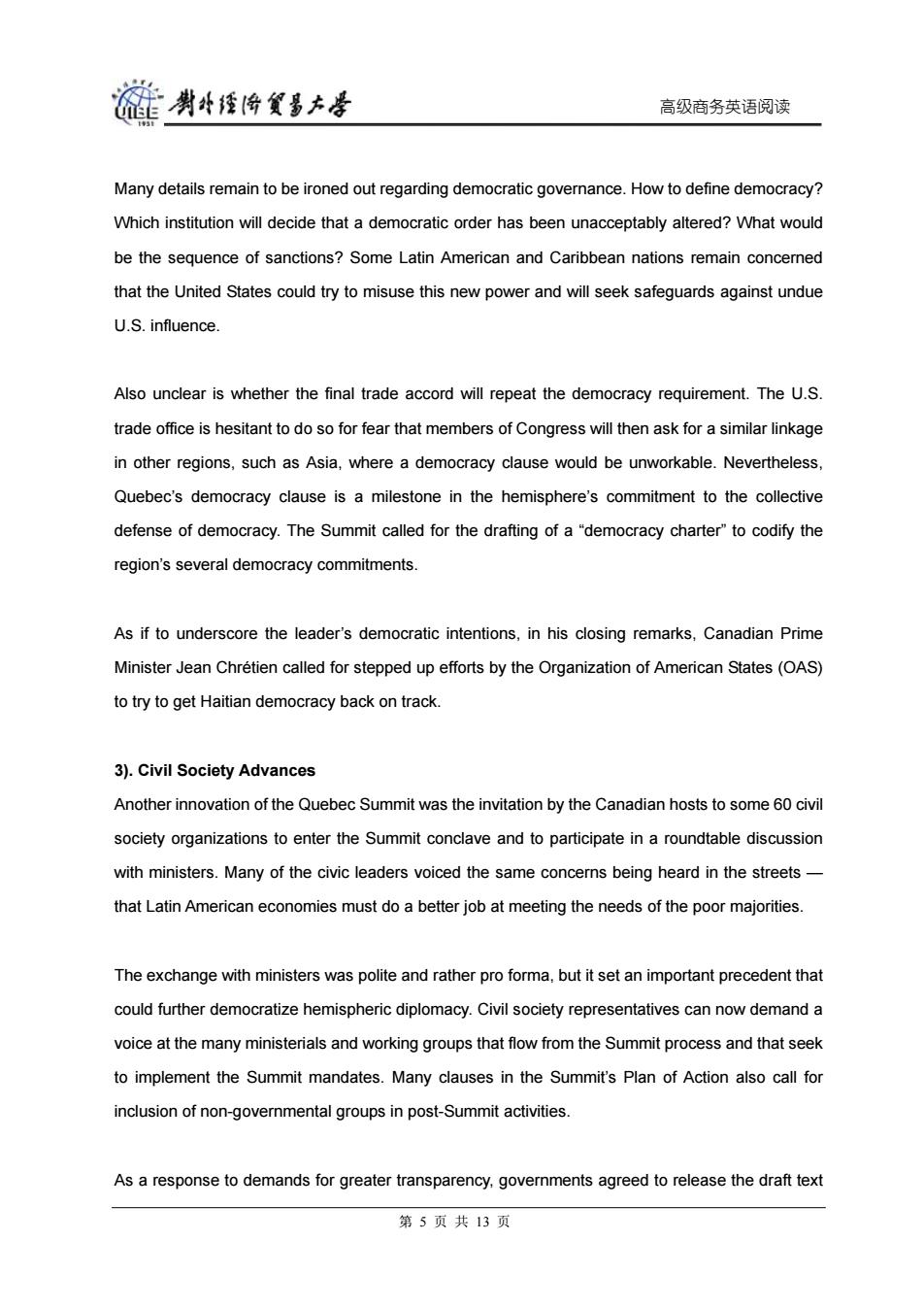
碰男华经净贸多大学 高级商务英语阅读 Many details remain to be ironed out regarding democratic governance.How to define democracy? Which institution will decide that a democratic order has been unacceptably altered?What would be the sequence of sanctions?Some Latin American and Caribbean nations remain concerned that the United States could try to misuse this new power and will seek safeguards against undue U.S.influence. Also unclear is whether the final trade accord will repeat the democracy requirement.The U.S. trade office is hesitant to do so for fear that members of Congress will then ask for a similar linkage in other regions,such as Asia,where a democracy clause would be unworkable.Nevertheless, Quebec's democracy clause is a milestone in the hemisphere's commitment to the collective defense of democracy.The Summit called for the drafting of a"democracy charter"to codify the region's several democracy commitments. As if to underscore the leader's democratic intentions,in his closing remarks,Canadian Prime Minister Jean Chretien called for stepped up efforts by the Organization of American States(OAS) to try to get Haitian democracy back on track. 3).Civil Society Advances Another innovation of the Quebec Summit was the invitation by the Canadian hosts to some 60 civil society organizations to enter the Summit conclave and to participate in a roundtable discussion with ministers.Many of the civic leaders voiced the same concerns being heard in the streets- that Latin American economies must do a better job at meeting the needs of the poor majorities. The exchange with ministers was polite and rather pro forma,but it set an important precedent that could further democratize hemispheric diplomacy.Civil society representatives can now demand a voice at the many ministerials and working groups that flow from the Summit process and that seek to implement the Summit mandates.Many clauses in the Summit's Plan of Action also call for inclusion of non-governmental groups in post-Summit activities. As a response to demands for greater transparency,governments agreed to release the draft text 第5页共13页
高级商务英语阅读 Many details remain to be ironed out regarding democratic governance. How to define democracy? Which institution will decide that a democratic order has been unacceptably altered? What would be the sequence of sanctions? Some Latin American and Caribbean nations remain concerned that the United States could try to misuse this new power and will seek safeguards against undue U.S. influence. Also unclear is whether the final trade accord will repeat the democracy requirement. The U.S. trade office is hesitant to do so for fear that members of Congress will then ask for a similar linkage in other regions, such as Asia, where a democracy clause would be unworkable. Nevertheless, Quebec’s democracy clause is a milestone in the hemisphere’s commitment to the collective defense of democracy. The Summit called for the drafting of a “democracy charter” to codify the region’s several democracy commitments. As if to underscore the leader’s democratic intentions, in his closing remarks, Canadian Prime Minister Jean Chrétien called for stepped up efforts by the Organization of American States (OAS) to try to get Haitian democracy back on track. 3). Civil Society Advances Another innovation of the Quebec Summit was the invitation by the Canadian hosts to some 60 civil society organizations to enter the Summit conclave and to participate in a roundtable discussion with ministers. Many of the civic leaders voiced the same concerns being heard in the streets — that Latin American economies must do a better job at meeting the needs of the poor majorities. The exchange with ministers was polite and rather pro forma, but it set an important precedent that could further democratize hemispheric diplomacy. Civil society representatives can now demand a voice at the many ministerials and working groups that flow from the Summit process and that seek to implement the Summit mandates. Many clauses in the Summit’s Plan of Action also call for inclusion of non-governmental groups in post-Summit activities. As a response to demands for greater transparency, governments agreed to release the draft text 第 5 页 共 13 页